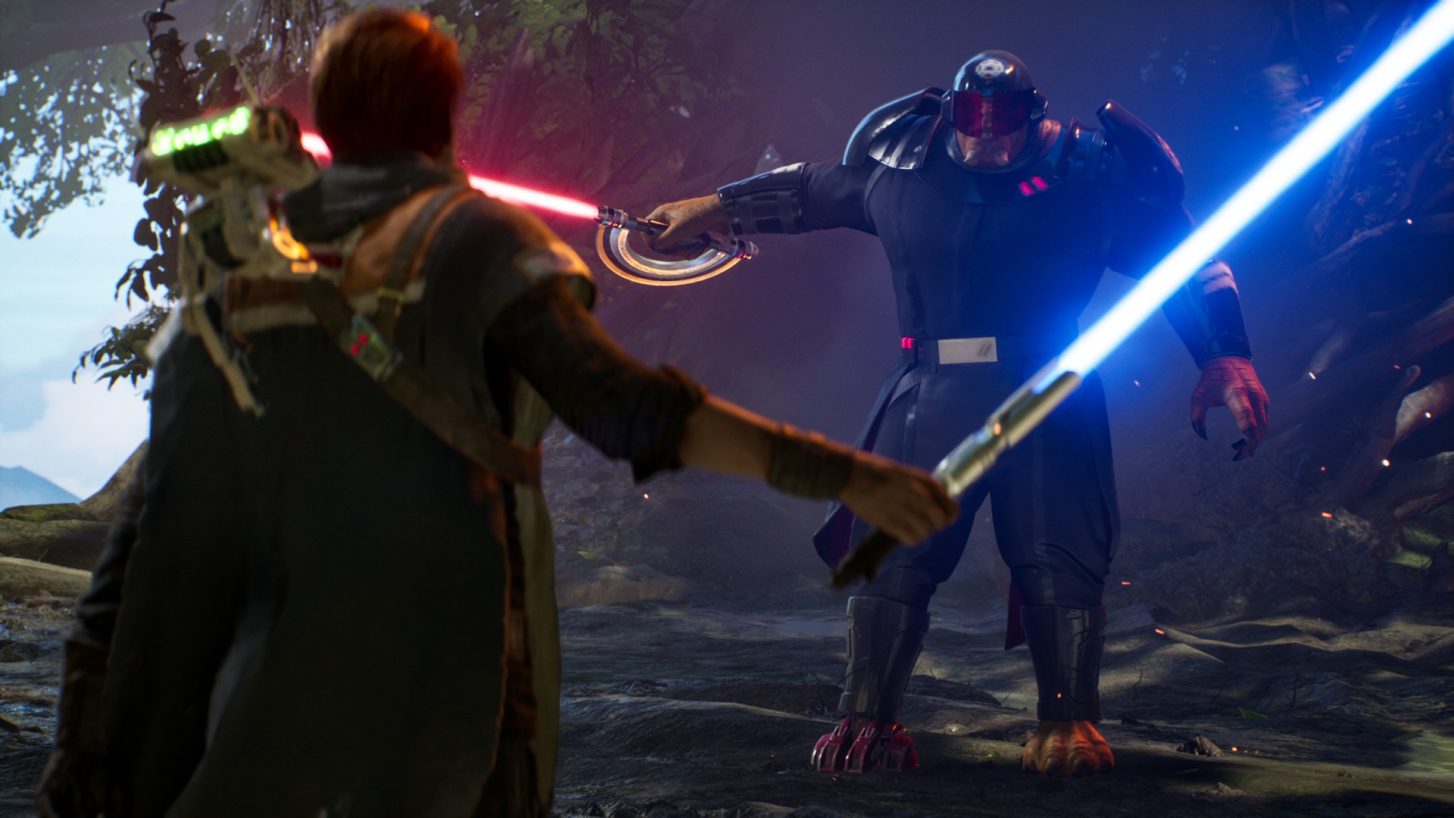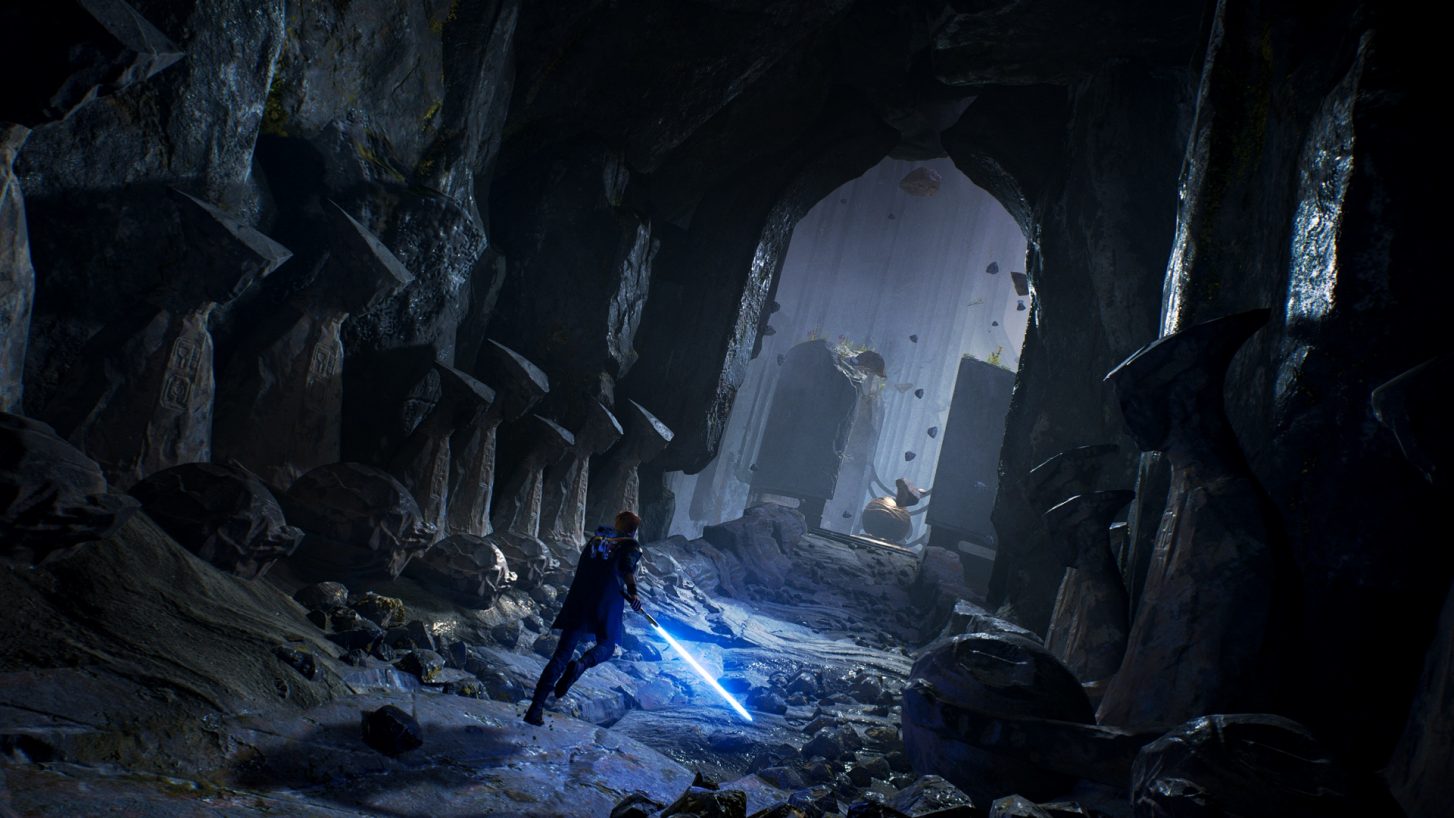I’m liberating the Wookie planet Kashykk from its Imperial oppressors. AT-ATs plod through the planet’s largest river and I swim up to its leg, scale the side of metallic beast and drop into its body through a hole on top. Inside, I come face to mask with Stormtroopers wielding stun batons. They’re the best the Empire has to offer, but I’m a Jedi. The familiar hum of the lightsaber fills the air and I use the Force to send the Stormtroopers stumbling before I leap forward and finish them off. It’s over fast. I am a Cal Kestis, one of the last Jedi in the galaxy and this is Star War Jedi: Fallen Order.
Star Wars Jedi: Fallen Order is a new video game developed by Respawn Entertainment—the team behind Apex Legends and the Titanfall series—and published EA. It’s out now on the PlayStation 4, Xbox One and PC. Fallen Order is a third person action game where players control KCalestis, a Jedi struggling to rebuild the Jedi Order after the events of the film Episode III: Revenge of the Sith.
Cal is a youngling Padawan when Emperor Palpatine executes Order 66, which all but destroys the Jedi order. Cal survives for five years on a scrap planet before the Empire discovers him and sends its elite Purge Troopers to finish him off. He escapes, just barely, and works with a rag-tag crew of misfits and outcasts to journey across the galaxy, fight the Empire and rebuild the Jedi Order.
Fallen Order is a Jedi simulator and I spent most of my 20 hours with the game exploring planets and swinging a lightsaber. Not since Jedi Academy has it been this much fun to cut through Imperial forces in a video game. Combat is focused and tough. Cal’s lightsaber is deadly, but so are the blasters and stun batons of the Stormtrooopers. Killing enemies requires timing and every combat encounter felt like a dual. Cal and the bad guys have stamina meters that are depleted by blocking. When I broke a Stormtroopers stamina meter, I could swing my lightsaber with abandon, often finishing them off in one hit. A correctly timed push of the block button would parry an incoming blow, destroying an opponent’s stun meter and opening them up for a counter attack. But enemies could parry me too, and their counter attacks were just as devastating.
This back and forth makes combat feel dynamic. I was never just smashing the attack button until my enemies fell, I was carefully considering the best way to deal with individual enemies. A quick parry would send the laser of a blaster-wielding Stormtrooper back at them, but elite Purge Troopers required more finesse and skill.

The Force powers come in handy here. As I killed enemies and explored Fallen Order’s worlds, I gained experience points which I used to unlock new Force abilities. Some of these are as simple as increased health and Force meters, but others unlocked whole new attacks. My favorite early game ability rushed Cal forward and delivered a devastating upswing with the lightsaber that would often break through an opponent’s block and set them up for a killing blow.
When I wasn’t slicing into Imperial soldiers, I was wandering around the various planets of a galaxy far far away. Fallen Order takes place on four main planets and I could travel freely between them, exploring as I wanted. These planets are large, detailed and full of secrets. They also look stunning. Kashyyyk is lush and swampy. Zeffo is icy and abandoned. Dothomir, the planet of the strange Nightsisters, is a foreboding blasted land of red crags and terrifying monsters. As I progressed the story, I learned new Force powers and gained new equipment that allowed me to better explore these planets and uncover their secrets.
The game is, primarily, about exploration. The combat is fun, but it serves mainly to break up the pace of exploration. Cal has the ability to touch objects and sense their past so a lot of the story is delivered through the objects I found wandering the planets. The more I explored, the more of the story I experienced and the better I understood what was at stake. To explore, I climbed buildings, swung from vines and used the Force to manipulate objects in the environment and solve puzzles. Often, Fallen Order feels like a great Tomb Raider game with lightsabers, magic powers and a better story.
That story and the performances of the main cast is one of Fallen Orders’ strengths. Cameron Monaghan plays Cal Kestis and nails the weary hero. His interactions with the droid BD-1, his constant companion during the adventure, lighten the game’s heavy mood. But it’s Debra Wilson as fallen Jedi Cere Junda who’s the emotional core of this tale.
Junda survived Order 66 with her Padawans but experienced something so terrible she’s cut herself off from the Force. She’s teamed up with Cal to help restore the Jedi Order, but she’s afraid to wield a lightsaber. Her backstory and character arc are a highlight of Fallen Order and are so well written they stand with the best the franchise has to offer, video game or otherwise.

Fallen Order is also blissfully free of microtransactions. EA’s previous Star Wars game, Battlefront II, made headlines and angered lawmakers by selling seemingly egregious loot boxes in-game. Fallen Order has no loot boxes, it’s just a straightforward single player experience with no outside pressure to spend more cash after you’ve already paid for the game.
Star Wars Jedi: Fallen Order is out now on PlayStation 4, Xbox One, and PC for $59.99.
More Must-Reads from TIME
- Why Trump’s Message Worked on Latino Men
- What Trump’s Win Could Mean for Housing
- The 100 Must-Read Books of 2024
- Sleep Doctors Share the 1 Tip That’s Changed Their Lives
- Column: Let’s Bring Back Romance
- What It’s Like to Have Long COVID As a Kid
- FX’s Say Nothing Is the Must-Watch Political Thriller of 2024
- Merle Bombardieri Is Helping People Make the Baby Decision
Contact us at letters@time.com